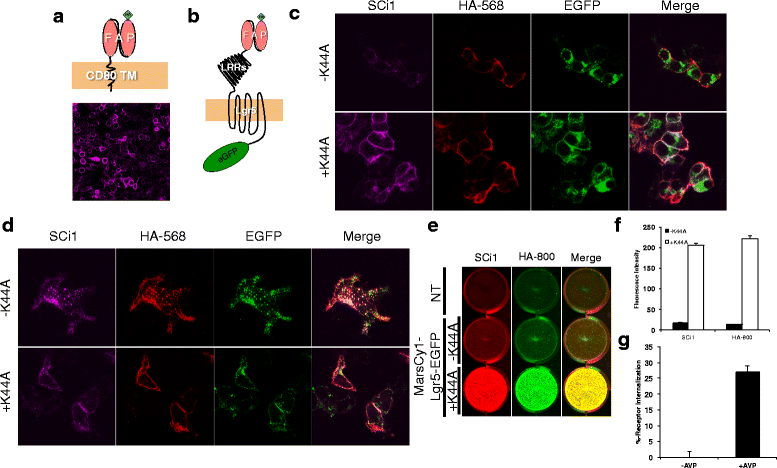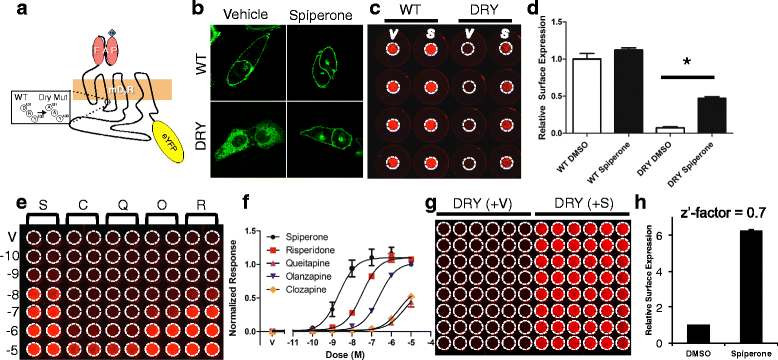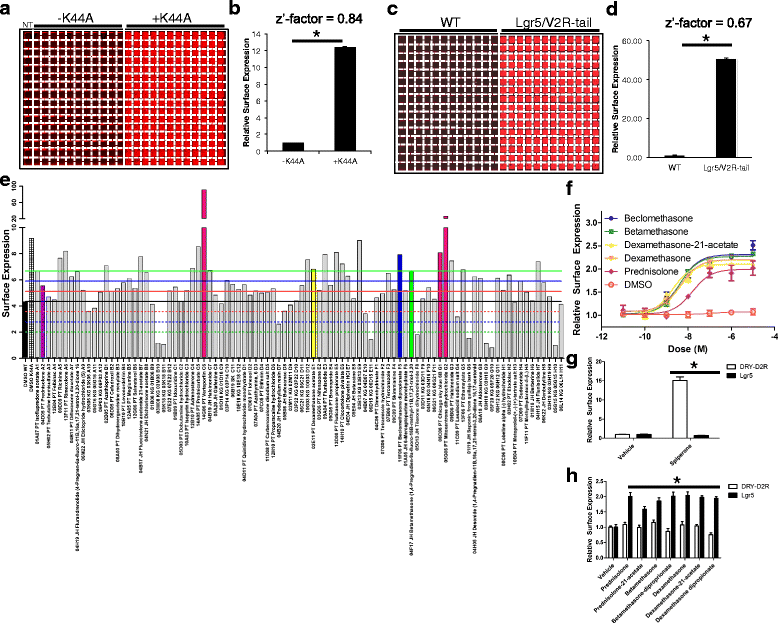A rapid and affordable screening platform for membrane protein trafficking
- PMID: 26678094
- PMCID: PMC4683952
- DOI: 10.1186/s12915-015-0216-3
A rapid and affordable screening platform for membrane protein trafficking
Abstract
Background: Membrane proteins regulate a diversity of physiological processes and are the most successful class of targets in drug discovery. However, the number of targets adequately explored in chemical space and the limited resources available for screening are significant problems shared by drug-discovery centers and small laboratories. Therefore, a low-cost and universally applicable screen for membrane protein trafficking was developed.
Results: This high-throughput screen (HTS), termed IRFAP-HTS, utilizes the recently described MarsCy1-fluorogen activating protein and the near-infrared and membrane impermeant fluorogen SCi1. The cell surface expression of MarsCy1 epitope-tagged receptors can be visualized by simple addition of SCi1. User-friendly, rapid, and quantitative detection occurs on a standard infrared western-blotting scanner. The reliability and robustness of IRFAP-HTS was validated by confirming human vasopressin-2 receptor and dopamine receptor-2 trafficking in response to agonist or antagonist. The IRFAP-HTS screen was deployed against the leucine-rich G protein-coupled receptor-5 (Lgr5). Lgr5 is expressed in stem cells, modulates Wnt/ß-catenin signaling, and is therefore a promising drug target. However, small molecule modulators have yet to be reported. The constitutive internalization of Lgr5 appears to be one primary mode through which its function is regulated. Therefore, IRFAP-HTS was utilized to screen 11,258 FDA-approved and drug-like small molecules for those that antagonize Lgr5 internalization. Glucocorticoids were found to potently increase Lgr5 expression at the plasma membrane.
Conclusion: The IRFAP-HTS platform provides a versatile solution for screening more targets with fewer resources. Using only a standard western-blotting scanner, we were able to screen 5,000 compounds per hour in a robust and quantitative assay. Multi-purposing standardly available laboratory equipment eliminates the need for idiosyncratic and more expensive high-content imaging systems. The modular and user-friendly IRFAP-HTS is a significant departure from current screening platforms. Small laboratories will have unprecedented access to a robust and reliable screening platform and will no longer be limited by the esoteric nature of assay development, data acquisition, and post-screening analysis. The discovery of glucocorticoids as modulators for Lgr5 trafficking confirms that IRFAP-HTS can accelerate drug-discovery and drug-repurposing for even the most obscure targets.
Figures



References
Publication types
MeSH terms
Substances
Grants and funding
- P30 DA029925/DA/NIDA NIH HHS/United States
- NCI 5 K12-CA100639-10/CA/NCI NIH HHS/United States
- U19 MH082441/MH/NIMH NIH HHS/United States
- NIH 1R33-CA191198/CA/NCI NIH HHS/United States
- 2U19-MH082441/MH/NIMH NIH HHS/United States
- NIH 5U54GM103529/GM/NIGMS NIH HHS/United States
- U54 GM103529/GM/NIGMS NIH HHS/United States
- NIGMS 5T32GM007105-39/PHS HHS/United States
- NIDA P30 5P30DA29925/PHS HHS/United States
- 5R37-MH073853/MH/NIMH NIH HHS/United States
- K12 CA100639/CA/NCI NIH HHS/United States
- R21 CA173245/CA/NCI NIH HHS/United States
- 1R21CA173245/CA/NCI NIH HHS/United States
- T32 GM007105/GM/NIGMS NIH HHS/United States
- R37 MH073853/MH/NIMH NIH HHS/United States
- R33 CA191198/CA/NCI NIH HHS/United States
LinkOut - more resources
Full Text Sources
Other Literature Sources

